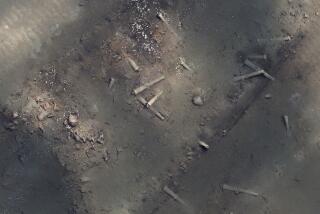‘Biggest Ships and Richest Cargoes’ : L.A. Adventurer Set to Start Treasure Hunt for Manila’s Galleons
MANILA — For years, Robert F. Marx has dreamed of the mighty Manila galleon fleet and the billions of dollars in treasure he believes it holds at the bottom of the seas around the Philippines.
For years, he traveled to the Vatican in Rome and the Spanish national archives in Madrid to study the ancient writings of Jesuit missionaries who lived here, trying to reassemble shards of history into what he hopes is a treasure map that will lead him to as many as 30 sunken galleons--”the biggest ships and the richest cargoes that ever sailed the high seas,” according to Marx.
“They were nothing less than floating Metropolitan Museums of Art. In one ship alone, there was at least a half-billion dollars in treasure,” he said.
Until now, though, the 50-year-old career adventurer and marine archeologist from Los Angeles had declined to begin his actual search for what he asserts could well be more than $13-billion worth of Mexican gold and silver, Chinese jade and ivory, Ming porcelain and ancient Indian jewels.
The problem: Former President Ferdinand E. Marcos and his wife, Imelda.
“This kind of thing couldn’t happen here before,” Marx said. “For more than 20 years, Marcos prevented people from working on shipwrecks because he thought anybody who was looking for shipwrecks was looking for Japanese treasures, which he and his wife controlled with an iron fist.”
Under the new government of President Corazon Aquino, Marx says he is optimistic. He says he trusts the new president and knows she will be sympathetic to his quest.
Aquino has opened the nation for the first time in decades to explorers and treasure hunters, and Marx is leading dozens of divers and diggers from all over the world now scouring the Philippines for everything from Japanese gold buried under schoolhouses or stashed in remote jungle caves to sunken treasure 500 feet beneath the ocean.
Among the treasure seekers is retired American Gen. John K. Singlaub, once an official of the CIA, who has opened an office in Manila. Singlaub has told top Aquino advisers and armed forces chiefs that he has launched a large-scale search for the legendary hidden gold of Japanese Lt. Gen. Tomoyuki Yamashita, who ruled the Philippines during its occupation by Japan during World War II.
Dozens of divers from Britain, France and Germany also have registered with the government to hunt for Yamashita’s gold.
The most ambitious venture by far, however, is Marx’s dream of locating and salvaging Manila galleons shipwrecked centuries ago.
In the past six weeks, Marx has raised more than $3 million from wealthy movie stars and athletes in Los Angeles in a limited partnership offering that will finance the next three years of search for the galleons.
Sailed for 300 Years
The huge cargo ships were built in the Philippines by Spaniards at a rate of two per year from 1565 until 1815 during Spain’s colonial rule here. The ships, which sailed between Manila and Acapulco for 300 years packed with precious cargo from the marketplaces of Manila and Mexico, weighed as much as 2,500 tons--1,000 tons heavier than the galleons built in Spain.
Both coming and going, the loaded galleons always took the same route through the narrow, treacherous straits of the east-central Philippines, and most eventually struck coral reefs and sank off the coast of the Philippine island of Samar.
Not a single Manila galleon survived the centuries, and none has ever been salvaged from the bottom of the sea.
But Marx, a veteran treasure hunter and marine archeologist who has traced and salvaged more than a dozen ancient shipwrecks throughout the world, has secured an exclusive contract from the Aquino government, authorizing him to search 18,500 square miles of Philippine waters and keep 70% of anything he finds. Marx claims to have recovered more than $500 million in treasure for 55 governments,
Marx’s search here, which will be done under the auspices of his Los Angeles-based Phoenician South Seas Treasures Ltd., will begin next month, he said.
That, however, is only the beginning. If and when Marx does salvage a galleon, he said he plans to use it as a model to build a replica and sail it across the same route followed by the Spaniards--to Japan, Alaska, San Francisco, Los Angeles and eventually Acapulco. Marx said he hoped to make the journey in 1992 in honor of the 500th anniversary of Christopher Columbus’ discovery of America.
Marx said he must study a salvaged galleon before he can build the replica, because not only were all the Manila galleons eventually lost, but all blueprints, drawings and specifications for their design were destroyed when the United States bombed Manila in the process of liberating the Philippines from Japanese occupation during World War II.
The idea has so excited officials in Aquino’s government that Tourism Minister Antonio Gonzalez and former Natural Resources Minister Ernesto Maceda have gotten into the act. Gonzalez has committed his ministry to promoting the project, and Maceda has formed a nonprofit foundation that will provide the wood for the replica galleon and market “commemorative items and souvenirs” to publicize the hoped-for journey.
After the planned voyage, Marx said, the galleon will be donated to the Philippine government, which will have paid nothing toward its construction or its journey.
“President Aquino knows all about it and thinks it’s great,” Marx said during one of several recent trips to Manila to plan the search.
According to documents accompanying the official offering of shares in Marx’s treasure-hunting partnership, the company will spend more than $1 million to rent a sophisticated, 100-foot search and salvage vessel. Marx owns the vessel. In addition, Marx will receive a salary of $75,000, and an additional $1 million will go toward the salaries of his crew.
If any treasure is found, it will be distributed equally among members of the partnership. As an example, the offering brochure declares that a treasure of $500 million, which Marx estimates is the likely value of the salvage from a single galleon, would bring a $2.7-million return on a $50,000 investment.
Not a Tax Shelter
Marx insisted that his South Seas Treasures is not a scam. And he said it cannot be a tax shelter for the super-rich because the partnership shares were offered after new tax laws went into effect restricting write-offs on such ventures.
Marx also pointed out that the prospectus contained a requirement that all investors prove a net worth of at least $1 million, not including real estate.
“Everybody who entered into this is rich already, so if we lose our shirts, no one will feel it,” he said. “We’re all just having fun and doing something that we care very deeply about.”
In addition, Marx’s statements about the Manila galleons, which he said are based on hundreds of hours of personal research throughout the world, have been confirmed independently by historians and long-time residents of Samar Island, which borders the San Bernardino Strait where Marx claims many of the galleons went down.
“There’s no doubt about it; there are galleons down there,” said Msgr. Tryphon Garduce. “I found one of them myself. It’s still down there.”
Garduce is a retired Philippine military chaplain living in the Samar coastal town of Lavezares. Now 76 and one of the foremost experts on his island’s history, Garduce said he found the Manila galleon at a depth of just 150 feet while scuba diving years ago. He has several Spanish gold coins and pieces of Chinese porcelain to prove it.
Based on his own research, Marx declared that “there are at least 30 Manila galleons just in my search area.” But he added: “You can’t just swim around on the bottom of the sea and pull them out. They’re buried, sometimes under 20 or 30 feet of sand.”
And so next month, Marx said, he and his 14-member crew will begin the task of scouring the sea with sonar, metal detectors and other equipment to chart the waters for what he expects to be three hard years of search and salvage work.
More to Read
Sign up for Essential California
The most important California stories and recommendations in your inbox every morning.
You may occasionally receive promotional content from the Los Angeles Times.










